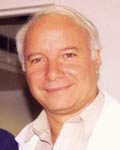 Prof Shimon Slavin
Prof Shimon Slavin
Head, Department of Bone Marrow Transplantation
and Cancer Immunotherapy Hadassah University Hospital Ein-Karem, Jerusalem
Prof. Shimon Slavin is
a renowned international leader in stem cell transplantation (SCT),
cancer immunotherapy and transplantation biology. Chairman of Israel’s
National Bone Marrow Transplantation Center. In addition, he has
been the director of the Baxter-Hadassah Research Center, director
of The Danny Cunniff Leukemia Research Laboratory and since 2001
has served as Medical Director of Cancer Immunotherapy at Cancer
Treatment Centers of America (CTCA). His contributions include a
new series of proprietary procedures and therapeutic tools for ultimate
treatment of an otherwise incurable broad spectrum of malignant and
non-malignant diseases.
External Academic Positions
Visiting Prof.: Univ. of Minn.; Univ. of Texas at Dallas
Univ. of Singapore.
Memberships and Fellowships:
Amer. Immunological Soc.; Int'l Transplantation Soc.; Amer. Federation
of Clinical Res.; Int'l Soc. for Experimental Hematology; Int'l Gnobotic
Soc.; Amer. Soc. of Hematology; Amer. Rheumatism Assn.; Isr. Med. Soc.;
Isr. Immunology Soc.; Isr. Soc. for Allergy and Clinical Immunology
Research
Interests
Bone marrow transplantation (BMT); mechanisms and induction of
transplantation tolerance; new approaches to leukemia and solid tumor
therapy focusing on cell and cytokine-mediated immunotherapy in
experimental animals and man; hematopoiesis and enhancement of
hematopoietic reconstitution by cytokines and new growth factors.
Treatment and mechanisms of autoimmune diseases in experimental animals
and man.
2007 - Bone Marrow Derived Cells and New Low-Molecular Weight Compounds for Tissue Regeneration and Delaying the Aging Process
PAST AACL CONFERENCES
2006 - Stem cells for
treatment of malignant and non-malignant diseases and
for tissue repair
Stem cells used in the context of autologous
and allogeneic stem cell transplantation can be used for the treatment
of an increasing number of malignant and non-malignant disorders,
including diseases caused by deficiency of bone marrow stem cells
or bone marrow derived cell subsets, a large variety of genetic disorders
and as of recently also for treatment of life threatening autoimmune
diseases. However, most stem cells transplant procedures are performed
for malignant indications. Standard treatment of patients with malignant
hematological diseases and certain metastatic solid tumors that cannot
be controlled by conventional chemotherapy, may involve the use of
high-dose chemoradiotherapy supported by autologous or preferably
allogeneic stem cell transplantation. However, although stem cell
transplantation can serve as an optimal therapeutic modality for
an increasing number of malignant and non-malignant diseases, procedure-related
toxicity and mortality as well as recurrence of the basic disease
on the one hand, and anti-host reactivity on the other, still represent
major obstacles. Considering the fact that adoptive
immunotherapy with alloreactive donor lymphocytes (primarily T cells,
not excluding NK and NK T cells) represent the major therapeutic component
of the bone marrow transplant (BMT) procedure, which can be accomplished
following induction of donor specific unresponsiveness following engraftment
of donor stem cells, replacing conventional myeloablative with reduced
intensity conditioning seemed justified. Indeed, in view of the therapeutic
potential of donor alloreactive lymphocytes in eradicating undesirable
hematopoietic cells of host origin, malignant (e.g. blood cancers & certain
metastatic solid tumors (e.g. renal cell cancer) and non-malignant
diseases (e.g. genetic diseases such as hemoglobinopathies; lysosomal
enzyme deficiency disorders; autoimmune diseases and diseases caused
by deficiency of stem cell products) we have documented that safer
transplantation can be accomplished by reduced intensity conditioning
(RIC) focusing on non-myeloablative stem cell transplantation (NST)
as a platform for subsequent adoptive allogeneic cell-mediated immunotherapy.
NST can be applied in elderly individuals, which represent the majority
of patients in need, as well as in patients with poor performance status,
normally excluded from BMT. In infants and young adults, NST
may provide a method for cure of otherwise lethal disease while avoiding
transplant related toxicity and mortality, reserving the reproductive
system and normal growth and development. For patients with malignant
diseases additional post transplant immunotherapy may be required for
elimination of cancer cells resistant to chemotherapy, however, in
treating deficiency and genetic diseases such as severe aplastic anemia
and Fanconi’s anemia, near 100% cure has been accomplished using
NST, with excellent quality of life and no severe GVHD. However, limited
anti-tumor responses on the one hand as well as the consequences of
acute and chronic GVHD on the other, can still represent major barriers
to further successful application of BMT for the treatment of patients
in need with malignant as well as non-malignant indications for stem
cell transplantation, especially those with no matched donor available. At
present, stem cell transplantation can be accomplished for al patients
in need using haploidentically mismatched family member (child to parent
or parent to child, or any half-matched family member) following engraftment
of donor stem cells T cell-depleted in vitro or in vivo (using positively
selected stem cells or negatively selected T cells using immunomagnetic
beads). Based on successful experiments in pre-clinical animal models,
we are now pioneering the use of specifically immune donor lymphocytes
and donor lymphocytes targeted with monoclonal or bispecific antibodies
sensitized in vitro and in vivo. For patients with genetic diseases
caused by deficiency or mutation of a recognized functional structural
gene, adequate correction of the basic abnormality may be accomplished
by gene therapy, mediated by transduction of patient’s own stem
cells. Successful gene therapy was already accomplished in 2
types of severe combined immune deficiency (SCID). Last but not least,
great progress has been made using adult stem cells for tissue repair,
based on the capacity of bone marrow-derived stem cells to differentiate
into blood vessels, bone, cartilage, fat with possible trans-differentiation
into other tissues such as nervous system cells, cardiomyocytes etc.,
mediated directly or indirectly by mesenchymal stem cells. Taken
together, autologous and/or allogeneic adult stem cells may provide
important tools for treatment of a broad spectrum of malignant and
non-malignant diseases as well as for tissue repair due to senescence,
trauma or degenerative disorders.